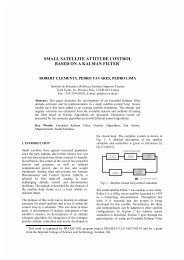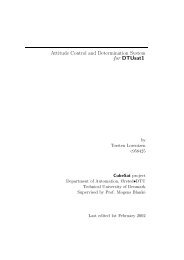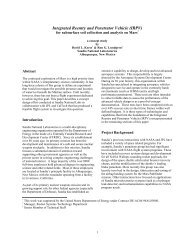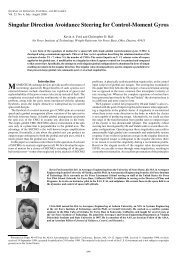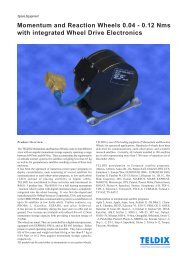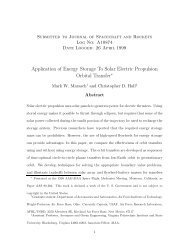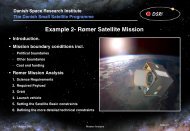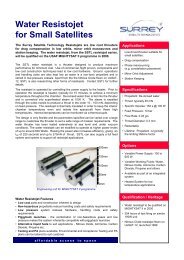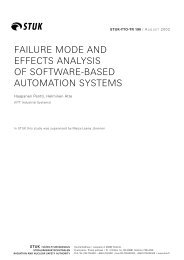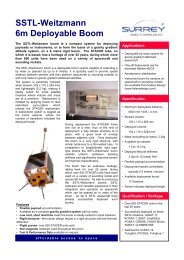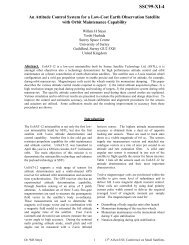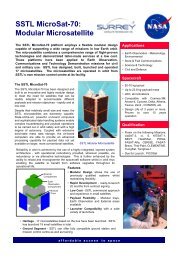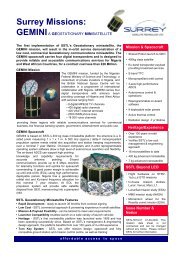Sea Launch User's Guide
Sea Launch User's Guide
Sea Launch User's Guide
You also want an ePaper? Increase the reach of your titles
YUMPU automatically turns print PDFs into web optimized ePapers that Google loves.
Tracking and data<br />
relay satellite system<br />
(TDRSS)<br />
<strong>Sea</strong> <strong>Launch</strong> uses a unique dual telemetry stream with the TDRSS. Telemetry<br />
is simultaneously received from the Zenit stages, the Block DM<br />
upper stage, and the payload unit during certain portions of the flight.<br />
The Block DM upper stage and payload unit data are combined, but the<br />
Zenit data is sent to a separate TDRSS receiver. Zenit data is received<br />
shortly after liftoff at approximately 9 sec, and continues until Zenit<br />
Stage 2/Block DM separation, at around 9 min. This data is routed from<br />
the NASA White Sands Ground Station to the <strong>Sea</strong> <strong>Launch</strong> Brewster<br />
ground station and to the ACS. The data is also recorded at White Sands<br />
and at Brewster for later playback to the KB Yuzhnoye design center.<br />
When the payload fairing separates, the payload unit transmitter shifts<br />
from sending high-rate payload accommodation data by LOS to sending<br />
combined payload unit/Block DM by TDRSS. The combined data is<br />
again routed from White Sands to Brewster, where it is separated into<br />
Block DM and payload unit data and then sent on to the ACS. The data is<br />
received on board the ship through the INTELSAT communications terminal<br />
and routed to room 15 for upper-stage data and room 94 for PLU<br />
data. Simultaneously, Brewster routes Block DM data to the Energia<br />
Moscow control center. TDRSS coverage continues until after playback<br />
of the recorded Block DM data. Data is also recorded at White Sands and<br />
Brewster for later playback.<br />
Russian tracking<br />
facilities and Moscow<br />
control center<br />
For missions where there may not be adequate TDRSS coverage, Russian<br />
tracking facilities may be brought on line. For low-inclination trajectories,<br />
the Block DM-SL will not be within LOS of the Russian tracking<br />
facilities until it obtains sufficient altitude. When the Block DM-SL is<br />
within LOS of a Russian tracking facility, telemetry is transmitted to the<br />
tracking facility and passed on to the Moscow control center and to the<br />
launch control center on the ACS by way of communication satellites.<br />
Telemetry recorded on board the Block DM-SL is also relayed to the<br />
ground station.<br />
The Zenit’s first and second stages are totally autonomous. A system<br />
called Kvant is also used during the countdown to load the flight data on<br />
board the Block DM-SL. When in view of ground stations, Kvant allows<br />
for an independent orbit determination by comparing uplink and<br />
downlink radio frequency carrier phase shifts. This orbit determination is<br />
separate from the onboard guidance telemetry.<br />
During all phases of launch processing and flight, the launch control<br />
center on the ACS has ultimate responsibility and authority for all decisions<br />
and commands affecting the launch vehicle, Block DM-SL, and the<br />
spacecraft.<br />
10-8 D688-10009-1 REV B



